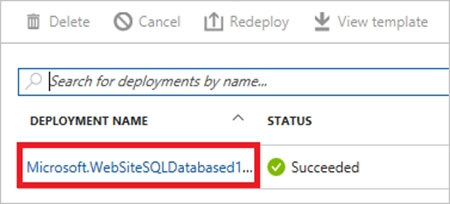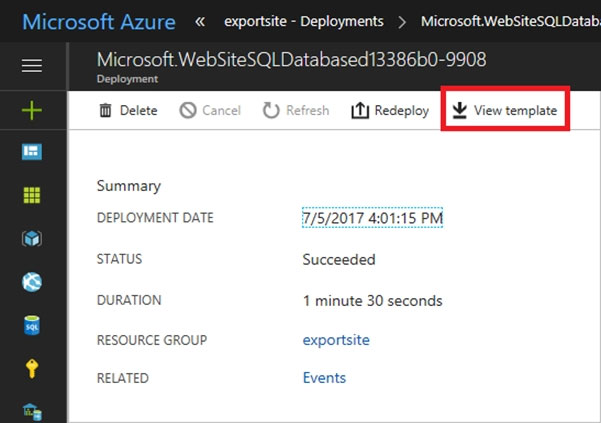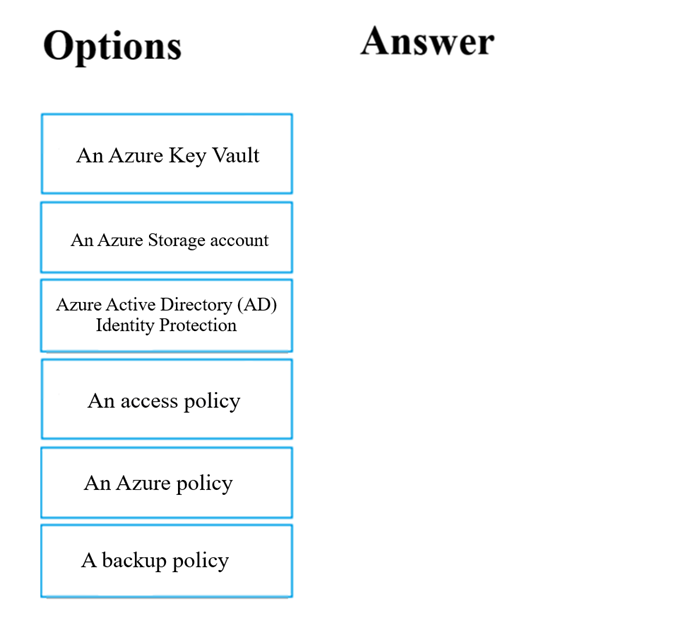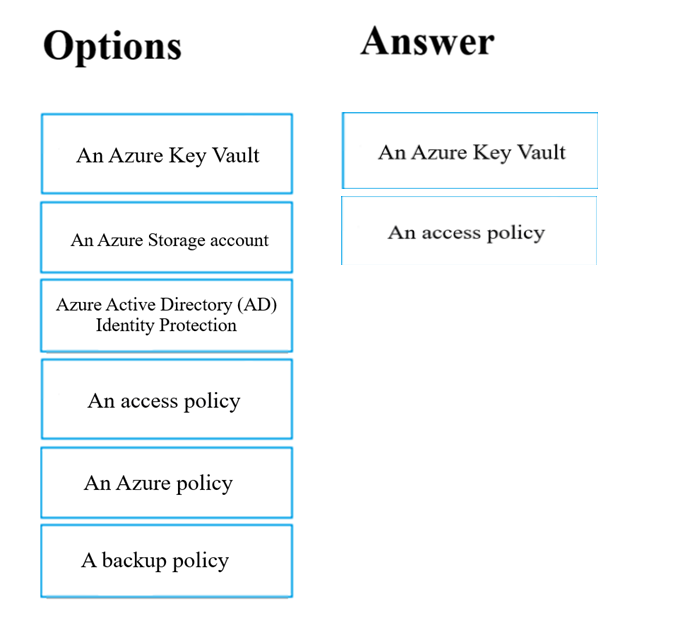Microsoft AZ-104 Exam Practice Questions (P. 2)
- Full Access (1153 questions)
- One Year of Premium Access
- Access to one million comments
- Seamless ChatGPT Integration
- Ability to download PDF files
- Anki Flashcard files for revision
- No Captcha & No AdSense
- Advanced Exam Configuration
Question #11
Note: The question is included in a number of questions that depicts the identical set-up. However, every question has a distinctive result. Establish if the solution satisfies the requirements.
Your company has an Azure Active Directory (Azure AD) tenant named weyland.com that is configured for hybrid coexistence with the on-premises Active
Directory domain.
You have a server named DirSync1 that is configured as a DirSync server.
You create a new user account in the on-premise Active Directory. You now need to replicate the user information to Azure AD immediately.
Solution: You restart the NetLogon service on a domain controller.
Does the solution meet the goal?
Your company has an Azure Active Directory (Azure AD) tenant named weyland.com that is configured for hybrid coexistence with the on-premises Active
Directory domain.
You have a server named DirSync1 that is configured as a DirSync server.
You create a new user account in the on-premise Active Directory. You now need to replicate the user information to Azure AD immediately.
Solution: You restart the NetLogon service on a domain controller.
Does the solution meet the goal?
- AYes
- BNoMost Voted
Correct Answer:
B
B
 GPT-4o - Answer
GPT-4o - Answer
Restarting the NetLogon service on a domain controller won't trigger Azure AD synchronization. To immediately sync the newly created on-premises user account with Azure AD, the correct approach is to use the PowerShell command Start-ADSyncSyncCycle with the parameter -PolicyType Delta. This initiates a delta synchronization, focusing on changes made since the last sync, thus updating Azure AD with the new user data without the need for a full re-sync, which would be significantly more time-consuming and resource-intensive.
send
light_mode
delete
Question #12
Your company has a Microsoft Azure subscription.
The company has datacenters in Los Angeles and New York.
You are configuring the two datacenters as geo-clustered sites for site resiliency.
You need to recommend an Azure storage redundancy option.
You have the following data storage requirements:
✑ Data must be stored on multiple nodes.
✑ Data must be stored on nodes in separate geographic locations.
✑ Data can be read from the secondary location as well as from the primary location.
Which of the following Azure stored redundancy options should you recommend?
The company has datacenters in Los Angeles and New York.
You are configuring the two datacenters as geo-clustered sites for site resiliency.
You need to recommend an Azure storage redundancy option.
You have the following data storage requirements:
✑ Data must be stored on multiple nodes.
✑ Data must be stored on nodes in separate geographic locations.
✑ Data can be read from the secondary location as well as from the primary location.
Which of the following Azure stored redundancy options should you recommend?
- AGeo-redundant storage
- BRead-only geo-redundant storageMost Voted
- CZone-redundant storage
- DLocally redundant storage
Correct Answer:
B
RA-GRS allows you to have higher read availability for your storage account by providing ג€read onlyג€ access to the data replicated to the secondary location. Once you enable this feature, the secondary location may be used to achieve higher availability in the event the data is not available in the primary region. This is an
ג€opt-inג€ feature which requires the storage account be geo-replicated.
Reference:
https://docs.microsoft.com/en-us/azure/storage/common/storage-redundancy
B
RA-GRS allows you to have higher read availability for your storage account by providing ג€read onlyג€ access to the data replicated to the secondary location. Once you enable this feature, the secondary location may be used to achieve higher availability in the event the data is not available in the primary region. This is an
ג€opt-inג€ feature which requires the storage account be geo-replicated.
Reference:
https://docs.microsoft.com/en-us/azure/storage/common/storage-redundancy
send
light_mode
delete
Question #13
Note: The question is included in a number of questions that depicts the identical set-up. However, every question has a distinctive result. Establish if the solution satisfies the requirements.
Your company has an azure subscription that includes a storage account, a resource group, a blob container and a file share.
A colleague named Jon Ross makes use of a solitary Azure Resource Manager (ARM) template to deploy a virtual machine and an additional Azure Storage account.
You want to review the ARM template that was used by Jon Ross.
Solution: You access the Virtual Machine blade.
Does the solution meet the goal?
Your company has an azure subscription that includes a storage account, a resource group, a blob container and a file share.
A colleague named Jon Ross makes use of a solitary Azure Resource Manager (ARM) template to deploy a virtual machine and an additional Azure Storage account.
You want to review the ARM template that was used by Jon Ross.
Solution: You access the Virtual Machine blade.
Does the solution meet the goal?
- AYes
- BNoMost Voted
Correct Answer:
B
You should use the Resource Group blade
Reference:
https://docs.microsoft.com/en-us/azure/azure-resource-manager/resource-manager-export-template
B
You should use the Resource Group blade
Reference:
https://docs.microsoft.com/en-us/azure/azure-resource-manager/resource-manager-export-template
send
light_mode
delete
Question #14
Note: The question is included in a number of questions that depicts the identical set-up. However, every question has a distinctive result. Establish if the solution satisfies the requirements.
Your company has an azure subscription that includes a storage account, a resource group, a blob container and a file share.
A colleague named Jon Ross makes use of a solitary Azure Resource Manager (ARM) template to deploy a virtual machine and an additional Azure Storage account.
You want to review the ARM template that was used by Jon Ross.
Solution: You access the Resource Group blade.
Does the solution meet the goal?
Your company has an azure subscription that includes a storage account, a resource group, a blob container and a file share.
A colleague named Jon Ross makes use of a solitary Azure Resource Manager (ARM) template to deploy a virtual machine and an additional Azure Storage account.
You want to review the ARM template that was used by Jon Ross.
Solution: You access the Resource Group blade.
Does the solution meet the goal?
- AYesMost Voted
- BNo
Correct Answer:
A
To view a template from deployment history:
1. Go to the resource group for your new resource group. Notice that the portal shows the result of the last deployment. Select this link.

2. You see a history of deployments for the group. In your case, the portal probably lists only one deployment. Select this deployment.

3. The portal displays a summary of the deployment. The summary includes the status of the deployment and its operations and the values that you provided for parameters. To see the template that you used for the deployment, select View template.

Reference:
https://docs.microsoft.com/en-us/azure/azure-resource-manager/resource-manager-export-template
A
To view a template from deployment history:
1. Go to the resource group for your new resource group. Notice that the portal shows the result of the last deployment. Select this link.

2. You see a history of deployments for the group. In your case, the portal probably lists only one deployment. Select this deployment.

3. The portal displays a summary of the deployment. The summary includes the status of the deployment and its operations and the values that you provided for parameters. To see the template that you used for the deployment, select View template.

Reference:
https://docs.microsoft.com/en-us/azure/azure-resource-manager/resource-manager-export-template
send
light_mode
delete
Question #15
Note: The question is included in a number of questions that depicts the identical set-up. However, every question has a distinctive result. Establish if the solution satisfies the requirements.
Your company has an azure subscription that includes a storage account, a resource group, a blob container and a file share.
A colleague named Jon Ross makes use of a solitary Azure Resource Manager (ARM) template to deploy a virtual machine and an additional Azure Storage account.
You want to review the ARM template that was used by Jon Ross.
Solution: You access the Container blade.
Does the solution meet the goal?
Your company has an azure subscription that includes a storage account, a resource group, a blob container and a file share.
A colleague named Jon Ross makes use of a solitary Azure Resource Manager (ARM) template to deploy a virtual machine and an additional Azure Storage account.
You want to review the ARM template that was used by Jon Ross.
Solution: You access the Container blade.
Does the solution meet the goal?
- AYes
- BNoMost Voted
Correct Answer:
B
You should use the Resource Group blade
Reference:
https://docs.microsoft.com/en-us/azure/azure-resource-manager/resource-manager-export-template
B
You should use the Resource Group blade
Reference:
https://docs.microsoft.com/en-us/azure/azure-resource-manager/resource-manager-export-template
send
light_mode
delete
Question #16
Your company has three virtual machines (VMs) that are included in an availability set.
You try to resize one of the VMs, which returns an allocation failure message.
It is imperative that the VM is resized.
Which of the following actions should you take?
You try to resize one of the VMs, which returns an allocation failure message.
It is imperative that the VM is resized.
Which of the following actions should you take?
- AYou should only stop one of the VMs.
- BYou should stop two of the VMs.
- CYou should stop all three VMs.Most Voted
- DYou should remove the necessary VM from the availability set.
Correct Answer:
C
If the VM you wish to resize is part of an availability set, then you must stop all VMs in the availability set before changing the size of any VM in the availability set.
The reason all VMs in the availability set must be stopped before performing the resize operation to a size that requires different hardware is that all running VMs in the availability set must be using the same physical hardware cluster. Therefore, if a change of physical hardware cluster is required to change the VM size then all VMs must be first stopped and then restarted one-by-one to a different physical hardware clusters.
Reference:
https://azure.microsoft.com/es-es/blog/resize-virtual-machines/
C
If the VM you wish to resize is part of an availability set, then you must stop all VMs in the availability set before changing the size of any VM in the availability set.
The reason all VMs in the availability set must be stopped before performing the resize operation to a size that requires different hardware is that all running VMs in the availability set must be using the same physical hardware cluster. Therefore, if a change of physical hardware cluster is required to change the VM size then all VMs must be first stopped and then restarted one-by-one to a different physical hardware clusters.
Reference:
https://azure.microsoft.com/es-es/blog/resize-virtual-machines/
send
light_mode
delete
Question #17
You have an Azure virtual machine (VM) that has a single data disk. You have been tasked with attaching this data disk to another Azure VM.
You need to make sure that your strategy allows for the virtual machines to be offline for the least amount of time possible.
Which of the following is the action you should take FIRST?
You need to make sure that your strategy allows for the virtual machines to be offline for the least amount of time possible.
Which of the following is the action you should take FIRST?
- AStop the VM that includes the data disk.Most Voted
- BStop the VM that the data disk must be attached to.
- CDetach the data disk.
- DDelete the VM that includes the data disk.
Correct Answer:
A
Reference:
https://docs.microsoft.com/en-us/azure/virtual-machines/windows/detach-disk https://docs.microsoft.com/en-us/azure/lab-services/devtest-lab-attach-detach-data-disk
A
Reference:
https://docs.microsoft.com/en-us/azure/virtual-machines/windows/detach-disk https://docs.microsoft.com/en-us/azure/lab-services/devtest-lab-attach-detach-data-disk
send
light_mode
delete
Question #18
Your company has an Azure subscription.
You need to deploy a number of Azure virtual machines (VMs) using Azure Resource Manager (ARM) templates. You have been informed that the VMs will be included in a single availability set.
You are required to make sure that the ARM template you configure allows for as many VMs as possible to remain accessible in the event of fabric failure or maintenance.
Which of the following is the value that you should configure for the platformFaultDomainCount property?
You need to deploy a number of Azure virtual machines (VMs) using Azure Resource Manager (ARM) templates. You have been informed that the VMs will be included in a single availability set.
You are required to make sure that the ARM template you configure allows for as many VMs as possible to remain accessible in the event of fabric failure or maintenance.
Which of the following is the value that you should configure for the platformFaultDomainCount property?
- A10
- B30
- CMin Value
- DMax ValueMost Voted
Correct Answer:
D
The number of fault domains for managed availability sets varies by region - either two or three per region.
Reference:
https://docs.microsoft.com/en-us/azure/virtual-machines/windows/manage-availability
D
The number of fault domains for managed availability sets varies by region - either two or three per region.
Reference:
https://docs.microsoft.com/en-us/azure/virtual-machines/windows/manage-availability
send
light_mode
delete
Question #19
Your company has an Azure subscription.
You need to deploy a number of Azure virtual machines (VMs) using Azure Resource Manager (ARM) templates. You have been informed that the VMs will be included in a single availability set.
You are required to make sure that the ARM template you configure allows for as many VMs as possible to remain accessible in the event of fabric failure or maintenance.
Which of the following is the value that you should configure for the platformUpdateDomainCount property?
You need to deploy a number of Azure virtual machines (VMs) using Azure Resource Manager (ARM) templates. You have been informed that the VMs will be included in a single availability set.
You are required to make sure that the ARM template you configure allows for as many VMs as possible to remain accessible in the event of fabric failure or maintenance.
Which of the following is the value that you should configure for the platformUpdateDomainCount property?
- A10
- B20Most Voted
- C30
- D40
Correct Answer:
B
Each virtual machine in your availability set is assigned an update domain and a fault domain by the underlying Azure platform. For a given availability set, five non-user-configurable update domains are assigned by default (Resource Manager deployments can then be increased to provide up to 20 update domains) to indicate groups of virtual machines and underlying physical hardware that can be rebooted at the same time.
Reference:
https://docs.microsoft.com/en-us/azure/virtual-machines/availability-set-overview
B
Each virtual machine in your availability set is assigned an update domain and a fault domain by the underlying Azure platform. For a given availability set, five non-user-configurable update domains are assigned by default (Resource Manager deployments can then be increased to provide up to 20 update domains) to indicate groups of virtual machines and underlying physical hardware that can be rebooted at the same time.
Reference:
https://docs.microsoft.com/en-us/azure/virtual-machines/availability-set-overview
send
light_mode
delete
Question #20
DRAG DROP -
You have downloaded an Azure Resource Manager (ARM) template to deploy numerous virtual machines (VMs). The ARM template is based on a current VM, but must be adapted to reference an administrative password.
You need to make sure that the password cannot be stored in plain text.
You are preparing to create the necessary components to achieve your goal.
Which of the following should you create to achieve your goal? Answer by dragging the correct option from the list to the answer area.
Select and Place:

You have downloaded an Azure Resource Manager (ARM) template to deploy numerous virtual machines (VMs). The ARM template is based on a current VM, but must be adapted to reference an administrative password.
You need to make sure that the password cannot be stored in plain text.
You are preparing to create the necessary components to achieve your goal.
Which of the following should you create to achieve your goal? Answer by dragging the correct option from the list to the answer area.
Select and Place:

Correct Answer:

You can use a template that allows you to deploy a simple Windows VM by retrieving the password that is stored in a Key Vault. Therefore, the password is never put in plain text in the template parameter file.

You can use a template that allows you to deploy a simple Windows VM by retrieving the password that is stored in a Key Vault. Therefore, the password is never put in plain text in the template parameter file.
send
light_mode
delete
All Pages
